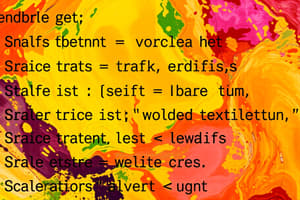Podcast
Questions and Answers
Consider a scenario where a Swift array, declared as a constant, undergoes a series of transformations within a complex algorithm. Which statement regarding its immutability holds true under all circumstances?
Consider a scenario where a Swift array, declared as a constant, undergoes a series of transformations within a complex algorithm. Which statement regarding its immutability holds true under all circumstances?
- The array's size cannot be altered, but the values of its elements can be mutated if the element type is a mutable value type.
- Both the size and the individual values within the array are guaranteed to remain unchanged throughout the program's execution, irrespective of external factors. (correct)
- While the array's elements themselves remain immutable, the reference to the array can be reassigned to a completely new array instance.
- Although the array is immutable, its contents can be indirectly modified through shared references to mutable objects contained within the array.
A Swift developer aims to create a highly performant data structure for managing unique identifiers in a system where frequent lookups are paramount. Between Array and Set, which choice offers superior lookup performance characteristics, and why?
A Swift developer aims to create a highly performant data structure for managing unique identifiers in a system where frequent lookups are paramount. Between Array and Set, which choice offers superior lookup performance characteristics, and why?
- `Set`, because it leverages hashing to provide average-case constant-time complexity for lookups, outperforming the linear time complexity of array-based searches. (correct)
- `Array`, provided it is meticulously sorted and employs a binary search algorithm, it can match the lookup speed of a `Set`.
- `Set`, because it maintains elements in a sorted order, allowing for efficient binary search during lookups.
- `Array`, because its contiguous memory layout ensures constant-time access to elements via indexing, making lookups inherently faster.
In the context of Swift collections, what are the precise implications of a type conforming to the Hashable protocol, particularly concerning its suitability for use as a Set element or a Dictionary key?
In the context of Swift collections, what are the precise implications of a type conforming to the Hashable protocol, particularly concerning its suitability for use as a Set element or a Dictionary key?
- Conformance to `Hashable` ensures only that unique instances of the type can be created, but provides no guarantees about the efficiency of lookups or comparisons.
- Conformance to `Hashable` implies that the type is also `Comparable`, allowing for lexicographical ordering within collections, which is essential for certain set operations.
- Conformance to `Hashable` mandates the implementation of an algorithm that generates a unique integer for each instance, enabling efficient storage and retrieval in hash-based collections.
- Conformance to `Hashable` necessitates the provision of a mechanism to compute an integer hash value such that equal instances _always_ produce the same hash value, facilitating efficient equality checks and lookups. (correct)
Given an array of [String] in Swift, what is the most efficient way to remove duplicate strings while preserving insertion order?
Given an array of [String] in Swift, what is the most efficient way to remove duplicate strings while preserving insertion order?
Consider a Swift Dictionary where both keys and values are complex objects with custom equality and hashing implementations. What potential pitfalls should be carefully considered to ensure the dictionary functions correctly and efficiently?
Consider a Swift Dictionary where both keys and values are complex objects with custom equality and hashing implementations. What potential pitfalls should be carefully considered to ensure the dictionary functions correctly and efficiently?
In Swift, what is the underlying mechanism that enables the Set collection to enforce uniqueness among its elements, and how does it impact the performance characteristics of common set operations?
In Swift, what is the underlying mechanism that enables the Set collection to enforce uniqueness among its elements, and how does it impact the performance characteristics of common set operations?
What are the implications of using value types (structs and enums) as elements within Swift arrays in terms of memory management and copy semantics, especially when dealing with large arrays and frequent modifications?
What are the implications of using value types (structs and enums) as elements within Swift arrays in terms of memory management and copy semantics, especially when dealing with large arrays and frequent modifications?
Which of the following scenarios would disproportionately favor the use of a Set over an Array in Swift, assuming both are equally capable of storing the required data?
Which of the following scenarios would disproportionately favor the use of a Set over an Array in Swift, assuming both are equally capable of storing the required data?
What is the behavior of the remove(at:) method on a Swift array when the provided index is equal to the array's count property?
What is the behavior of the remove(at:) method on a Swift array when the provided index is equal to the array's count property?
What considerations must be taken into account when using custom types as keys in a Swift Dictionary to ensure correctness and efficiency?
What considerations must be taken into account when using custom types as keys in a Swift Dictionary to ensure correctness and efficiency?
What is the time complexity of inserting an element into a Swift Array at the beginning (index 0) of the array, and why?
What is the time complexity of inserting an element into a Swift Array at the beginning (index 0) of the array, and why?
In Swift, which method should be used to most efficiently remove all elements from a Set, and what is its impact on the Set's capacity?
In Swift, which method should be used to most efficiently remove all elements from a Set, and what is its impact on the Set's capacity?
What is the difference between using map and compactMap on an array of optional values in Swift, and in what scenarios would compactMap be particularly advantageous?
What is the difference between using map and compactMap on an array of optional values in Swift, and in what scenarios would compactMap be particularly advantageous?
When should you use Set instead of Array when storing data?
When should you use Set instead of Array when storing data?
Given a Swift Array of type [Any], what are the primary challenges associated with accessing and manipulating its elements, and how can these challenges be addressed?
Given a Swift Array of type [Any], what are the primary challenges associated with accessing and manipulating its elements, and how can these challenges be addressed?
What are the potential performance implications of frequently converting between Array and Set in Swift, particularly when dealing with large collections?
What are the potential performance implications of frequently converting between Array and Set in Swift, particularly when dealing with large collections?
In Swift, how does the use of the where clause in a for-in loop impact the performance characteristics when iterating over a large Array, as opposed to using an if statement inside the loop?
In Swift, how does the use of the where clause in a for-in loop impact the performance characteristics when iterating over a large Array, as opposed to using an if statement inside the loop?
What is the significance of the ordering (or lack thereof) in Swift's Set collection regarding its suitability for various computational tasks, and how does this compare to the ordered nature of Array?
What is the significance of the ordering (or lack thereof) in Swift's Set collection regarding its suitability for various computational tasks, and how does this compare to the ordered nature of Array?
In the realm of Swift collections, how can one effectively implement a multi-key dictionary (i.e., a dictionary that allows accessing values using a combination of multiple keys) while adhering to the language's type safety and performance best practices?
In the realm of Swift collections, how can one effectively implement a multi-key dictionary (i.e., a dictionary that allows accessing values using a combination of multiple keys) while adhering to the language's type safety and performance best practices?
When working with large Swift arrays of value types, what strategies can be employed to minimize memory overhead and improve performance during operations that involve modifying the array's contents?
When working with large Swift arrays of value types, what strategies can be employed to minimize memory overhead and improve performance during operations that involve modifying the array's contents?
What are the implications of using String as the Element type in a Set concerning string interning and memory management in Swift?
What are the implications of using String as the Element type in a Set concerning string interning and memory management in Swift?
Flashcards
What is an Array?
What is an Array?
Ordered collection of values, same value can appear multiple times.
What is a Set?
What is a Set?
Unordered collection of distinct values of the same type.
What are Dictionaries?
What are Dictionaries?
Unordered collections that store key-value pairs.
What are Mutable Collections?
What are Mutable Collections?
Signup and view all the flashcards
What are Immutable Collections?
What are Immutable Collections?
Signup and view all the flashcards
What is Array Type Syntax?
What is Array Type Syntax?
Signup and view all the flashcards
How do you create an empty array?
How do you create an empty array?
Signup and view all the flashcards
Creating an Array with a Default Value
Creating an Array with a Default Value
Signup and view all the flashcards
How do you combine two arrays?
How do you combine two arrays?
Signup and view all the flashcards
What is an Array Literal?
What is an Array Literal?
Signup and view all the flashcards
Accessing and Modifying an Array
Accessing and Modifying an Array
Signup and view all the flashcards
Adding items to the end of an Array
Adding items to the end of an Array
Signup and view all the flashcards
How do you find the number of items in an array?
How do you find the number of items in an array?
Signup and view all the flashcards
Adding multiple items to the end of an Array
Adding multiple items to the end of an Array
Signup and view all the flashcards
Iterating Over an Array
Iterating Over an Array
Signup and view all the flashcards
What is a Hashable Type?
What is a Hashable Type?
Signup and view all the flashcards
Creating and Initializing an Empty Set
Creating and Initializing an Empty Set
Signup and view all the flashcards
Adding items to a Set
Adding items to a Set
Signup and view all the flashcards
How do you iterate over a Set?
How do you iterate over a Set?
Signup and view all the flashcards
Study Notes
- Swift provides three collection types: arrays, sets, and dictionaries.
- Arrays are ordered collections of values, sets are unordered collections of unique values, and dictionaries are unordered collections of key-value associations.
- Swift collections are type-safe, preventing insertion of values with the wrong type.
Mutability of Collections
- Mutable collections can be changed after creation (adding, removing, or changing items) and are assigned to variables.
- Immutable collections cannot be changed after creation and are assigned to constants.
Arrays
- Arrays store values of the same type in an ordered list, allowing duplicate values.
Array Type Shorthand Syntax
- The full type of a Swift array is
Array<Element>, whereElementis the type of values the array stores. - A shorthand form is
[Element], which is the preferred syntax.
Creating an Empty Array
- Method 1: Use an empty array literal
[]when the type is already known. - Method 2: Use explicit initializer syntax, like
[Int](). - You can reassign an empty array using
[]to an existing variable.
Creating an Array with a Default Value
- Use
Array(repeating: value, count: number)to create an array with a specified size and default value.
Creating an Array by Adding Two Arrays Together
- Use the addition operator (
+) to combine two arrays of compatible types into a new array.
Creating an Array with an Array Literal
- Initialize an array using an array literal:
[value1, value2, value3]. - If the array literal contains values of the same type, Swift can infer the array's type.
Accessing and Modifying an Array
- Use the
countproperty to find the number of items in an array. - Use the
isEmptyproperty to check if the array is empty. - Use the
append(_:)method to add a new item to the end of an array. - Use the addition assignment operator (
+=) to append an array of one or more compatible items. - Retrieve a value using subscript syntax:
arrayName[index]. - Change an existing value using subscript syntax:
arrayName[index] = newValue. - Change a range of values using subscript syntax:
arrayName[range] = [newValue1, newValue2]. - Insert an item at a specified index using the
insert(_:at:)method. - Remove an item at a specified index using the
remove(at:)method; this method returns the removed item. - Remove the last item using the
removeLast()method; this method returns the removed item.
Iterating Over an Array
- Iterate over the values in an array using a
for-inloop. - Use the
enumerated()method to iterate over the array and get the index and value of each item.
Sets
- Sets store distinct values of the same type in a collection without a defined ordering.
- Sets are used when the order of items isn't important, or to ensure an item only appears once.
Hash Values for Set Types
- A type must be hashable to be stored in a set.
- Hashable types provide a way to compute a hash value for itself, where equal objects have the same hash value.
- Basic Swift types (String, Int, Double, Bool) and enumeration case values without associated values are hashable by default.
Set Type Syntax
- The type of a Swift set is written as
Set<Element>. - Sets do not have a shorthand form like arrays.
Creating and Initializing an Empty Set
- Method 1: Use initializer syntax:
Set<ElementType>(). - Method 2: Create an empty set with an empty array literal
[]if the type is already known.
Creating a Set with an Array Literal
- Initialize a set using an array literal:
Set<ElementType> = [value1, value2, value3]. - The type
Set<ElementType>must be explicitly declared. - Swift can infer the set's element type if the array literal contains values of only one type.
Accessing and Modifying a Set
- Use the
countproperty to find the number of items in a set. - Use the
isEmptyproperty to check if the set is empty. - Add a new item using the
insert(_:)method. - Remove an item using the
remove(_:)method, which returns the removed value ornilif the set didn't contain it. - Remove all items using the
removeAll()method. - Check whether a set contains a particular item using the
contains(_:)method.
Iterating Over a Set
- Iterate over the values in a set using a
for-inloop. - Use the
sorted()method to iterate over the values in a specific order.
Studying That Suits You
Use AI to generate personalized quizzes and flashcards to suit your learning preferences.




